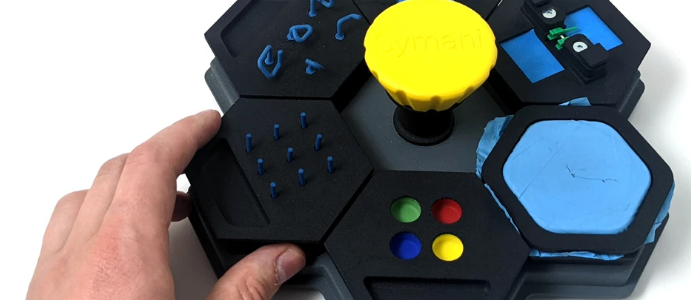19/10/23

Microsurgery is a complex and delicate procedure requiring tremendous dexterity. And precision is paramount as surgeons connect sub-millimeter vessels. MMI’s Symani Surgical System uses single-use sterile instruments to allow specialists to perform such demanding procedures. However, as there’s little margin for error in an operating theater, how could MMI support surgeons in training for this robotic approach? The company turned to additive manufacturing (AM) again for the answer — transforming its static and rigid exercise board into a modular, flexible, all-in-one solution.
Medical Microinstruments, Inc. (MMI) specializes in building a robotic system for microsurgeries. This surgical discipline “combines magnification with advanced diploscopes, specialized precision tools, and various operating techniques.”1 The company’s Symani Surgical System — which includes ‘NanoWrist’ instruments featuring the world’s smallest robotic wrist — supports surgeons in accurately connecting small veins, arteries, or nerves within the body as carefully as possible.
However, to use these micro-instruments effectively, surgeons must familiarize themselves with the system and practice in a safe and controlled environment. In the past, MMI’s previous exercise board for surgical training consisted of large, attached squares that were static and difficult to handle. The various exercises were spread out at different heights, making it difficult to change from one activity to the next, as both the robotic arms and the microscope had to be moved each time.
“The microscope has a small field of vision, and the trainer had to make constant adjustments which interrupted the surgeon’s focus. This took time to set up, breaking the immersive experience for the surgeon. Not to mention, moving the boards manually required the robotic arms to be raised or lowered in relation to the exercise boards,” says Elias Rosseau, Design Engineer at Materialise Manufacturing. “You want the surgeon to stay focused, concentrate on the exercise at hand, and not be distracted by such details.” So, how did MMI navigate this particular challenge? MMI partnered with our Design & Engineering team at Materialise Manufacturing to develop a solution that utilized 3D printing (3DP) — mainly a complete redesign of the exercise board.
“The initial board was fragmented and had to be assembled by hand: MMI’s team wanted to make it more ergonomic, easier to use, and professional,” says Elias. After three months and a few iterations, including multiple feedback loops between MMI and the Manufacturing Team’s engineering department, the two teams co-created the new modular board. “It was a co-creative process that involved trying and replacing different modules until we found those pieces that worked,” says Dries Vandecruys, Engineering Services Manager at Materialise Manufacturing.
The new training board comprises six honey-shaped or hexagonal modules made from PA 12 material using selective laser sintering (SLS) technology. These six pieces combine to create a gear-shaped device that’s more circular and compact in design. Although the modules are 3D printed, the board uses some traditionally manufactured parts. The base was produced using vacuum casting and mounted on a stainless steel laser-cut plate to add weight and stability to the design — with the assembly done by certified manufacturing. The team decided to use SLS, which was the most economically attractive option and allowed for small quantities and quick lead times.